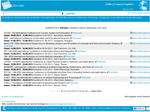Beyond IC Design - Challenges for the Next Generation of EDA Software
Hermann Eul, Infineon
Abstract:
Internet and Mobile Communication represent the revolution in communication technology in the past two decades. Only 17 years after release of the GSM standard more than 2.5 billion mobile phone users worldwide are registered in 2007. Market observers expect a sales volume of more than 1 billion handset devices in 2007.
In May 2007 Infineon has released the 2nd generation of an Ultra Low Cost mobile phone system platform. The ULC platform enjoys technological leadership since Infineon was first in the successful integration of mobile phone baseband IC with the RF transceiver on a single SoC in standard CMOS technology.
During the development of this platform we faced the challenge that the available EDA tools do not sufficiently support the development of such complex systems. We derived 3 major areas in which we expect the EDA industry to contribute with innovative solutions in the near future. Especially the larger EDA vendors are required to move here more quickly as they provide key components of the EDA design system infrastructure used by the semiconductor industry.
First importance has the seamless integration of system development, firmware development and circuit design. It is of utmost importance to have these three development processes synchronized from the early architectural exploration until final system verification and validation.
Any mismatch of modeling and simulation increases the risk of system failure and cause difficulties in the qualification of the circuits. In this area we would like to see more engagement by the EDA/IP industry towards the development and adoption of open standards ensuring a reliable system design flow over the complete development cycle.
Secondly the significant progress in RF-CMOS implementation allows an integration of highly complex digital components with analogue RF-blocks on the same silicon die. Today the design teams experience the absence of integrated development and verification solutions. Insufficient pre-silicon verification results in costly re-design cycles. Here the EDA industry is asked to integrate their respective functionality to more complete environments.
The third area for improvement is the growing interdependency between circuit and package design. A prominent example is the new Wafer-Level-Ball Grid (WLB) packaging technology which is the next step towards the BoM reduction. Today the EDA industry does not provide sufficient support for the concurrent and integrated design of both circuit and package forcing the semiconductor industry to compensate this with additional efforts and internal tools.
Biography
 Hermann Eul Member of the Management BoardExecutive Vice PresidentHead of Communication Business GroupInfineon Technologies AG
Hermann Eul Member of the Management BoardExecutive Vice PresidentHead of Communication Business GroupInfineon Technologies AG
Professor Hermann Eul studied electrical engineering and has a doctorate and professorate in engineering.
Until 1999 Professor Eul was General Manager of the Digital TeleCom and Data Com ICs operations at Siemens.
When Infineon was formed, he took over the Wireless Baseband and Systems Business Group as Vice President and General Manager. From 2001 to 2002 he was responsible for Security & Chip Card ICs operations as Chief Executive Officer.
In 2003 he was appointed as full Professor and Head of Faculty Chair for RF-Technology and Radio-Systems at the Hanover University. In 2004 he returned to Infineon where he first managed the Wireline Communications business group as Senior Vice President and General Manager and then, following the reorganization, he became the Group Vice President and General Manager of the Communication Solutions business group.
Professor Eul became a member of the Infineon Management Board in July 2005. He is responsible for the Communication Solutions business group.











